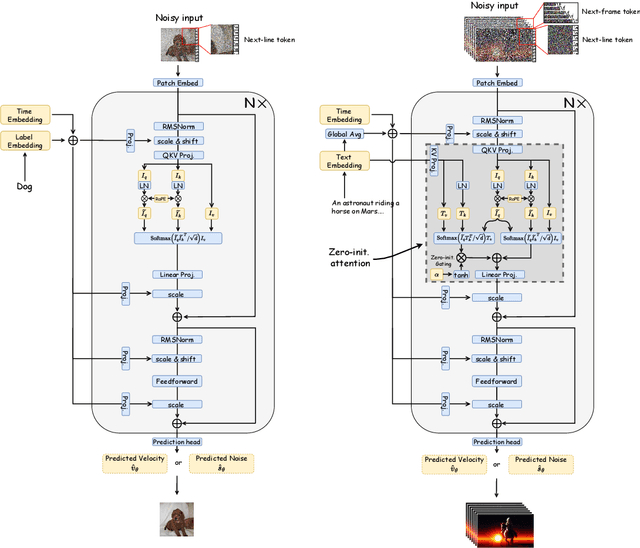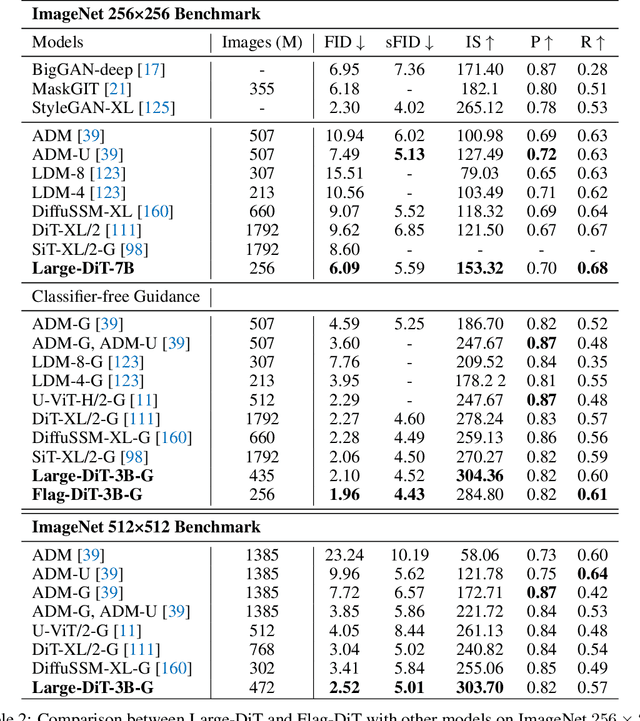Xu Luo
Shortcut Learning in Generalist Robot Policies: The Role of Dataset Diversity and Fragmentation
Aug 08, 2025Abstract:Generalist robot policies trained on large-scale datasets such as Open X-Embodiment (OXE) demonstrate strong performance across a wide range of tasks. However, they often struggle to generalize beyond the distribution of their training data. In this paper, we investigate the underlying cause of this limited generalization capability. We identify shortcut learning -- the reliance on task-irrelevant features -- as a key impediment to generalization. Through comprehensive theoretical and empirical analysis, we uncover two primary contributors to shortcut learning: (1) limited diversity within individual sub-datasets, and (2) significant distributional disparities across sub-datasets, leading to dataset fragmentation. These issues arise from the inherent structure of large-scale datasets like OXE, which are typically composed of multiple sub-datasets collected independently across varied environments and embodiments. Our findings provide critical insights into dataset collection strategies that can reduce shortcut learning and enhance the generalization ability of generalist robot policies. Moreover, in scenarios where acquiring new large-scale data is impractical, we demonstrate that carefully selected robotic data augmentation strategies can effectively reduce shortcut learning in existing offline datasets, thereby improving generalization capabilities of generalist robot policies, e.g., $\pi_0$, in both simulation and real-world environments. More information at https://lucky-light-sun.github.io/proj/shortcut-learning-in-grps/.
Unlocking Smarter Device Control: Foresighted Planning with a World Model-Driven Code Execution Approach
May 22, 2025Abstract:The automatic control of mobile devices is essential for efficiently performing complex tasks that involve multiple sequential steps. However, these tasks pose significant challenges due to the limited environmental information available at each step, primarily through visual observations. As a result, current approaches, which typically rely on reactive policies, focus solely on immediate observations and often lead to suboptimal decision-making. To address this problem, we propose \textbf{Foresighted Planning with World Model-Driven Code Execution (FPWC)},a framework that prioritizes natural language understanding and structured reasoning to enhance the agent's global understanding of the environment by developing a task-oriented, refinable \emph{world model} at the outset of the task. Foresighted actions are subsequently generated through iterative planning within this world model, executed in the form of executable code. Extensive experiments conducted in simulated environments and on real mobile devices demonstrate that our method outperforms previous approaches, particularly achieving a 44.4\% relative improvement in task success rate compared to the state-of-the-art in the simulated environment. Code and demo are provided in the supplementary material.
InSpire: Vision-Language-Action Models with Intrinsic Spatial Reasoning
May 20, 2025Abstract:Leveraging pretrained Vision-Language Models (VLMs) to map language instruction and visual observations to raw low-level actions, Vision-Language-Action models (VLAs) hold great promise for achieving general-purpose robotic systems. Despite their advancements, existing VLAs tend to spuriously correlate task-irrelevant visual features with actions, limiting their generalization capacity beyond the training data. To tackle this challenge, we propose Intrinsic Spatial Reasoning (InSpire), a simple yet effective approach that mitigates the adverse effects of spurious correlations by boosting the spatial reasoning ability of VLAs. Specifically, InSpire redirects the VLA's attention to task-relevant factors by prepending the question "In which direction is the [object] relative to the robot?" to the language instruction and aligning the answer "right/left/up/down/front/back/grasped" and predicted actions with the ground-truth. Notably, InSpire can be used as a plugin to enhance existing autoregressive VLAs, requiring no extra training data or interaction with other large models. Extensive experimental results in both simulation and real-world environments demonstrate the effectiveness and flexibility of our approach. Our code, pretrained models and demos are publicly available at: https://Koorye.github.io/proj/Inspire.
Policy Contrastive Decoding for Robotic Foundation Models
May 19, 2025Abstract:Robotic foundation models, or generalist robot policies, hold immense potential to enable flexible, general-purpose and dexterous robotic systems. Despite their advancements, our empirical experiments reveal that existing robot policies are prone to learning spurious correlations from pre-training trajectories, adversely affecting their generalization capabilities beyond the training data. To tackle this, we propose a novel Policy Contrastive Decoding (PCD) approach, which redirects the robot policy's focus toward object-relevant visual clues by contrasting action probability distributions derived from original and object-masked visual inputs. As a training-free method, our PCD can be used as a plugin to improve different types of robot policies without needing to finetune or access model weights. We conduct extensive experiments on top of three open-source robot policies, including the autoregressive policy OpenVLA and the diffusion-based policies Octo and $\pi_0$. The obtained results in both simulation and real-world environments prove PCD's flexibility and effectiveness, e.g., PCD enhances the state-of-the-art policy $\pi_0$ by 8% in the simulation environment and by 108% in the real-world environment. Code and demos are publicly available at: https://Koorye.github.io/proj/PCD.
Semantic Data Augmentation Enhanced Invariant Risk Minimization for Medical Image Domain Generalization
Feb 08, 2025Abstract:Deep learning has achieved remarkable success in medical image classification. However, its clinical application is often hindered by data heterogeneity caused by variations in scanner vendors, imaging protocols, and operators. Approaches such as invariant risk minimization (IRM) aim to address this challenge of out-of-distribution generalization. For instance, VIRM improves upon IRM by tackling the issue of insufficient feature support overlap, demonstrating promising potential. Nonetheless, these methods face limitations in medical imaging due to the scarcity of annotated data and the inefficiency of augmentation strategies. To address these issues, we propose a novel domain-oriented direction selector to replace the random augmentation strategy used in VIRM. Our method leverages inter-domain covariance as a guider for augmentation direction, guiding data augmentation towards the target domain. This approach effectively reduces domain discrepancies and enhances generalization performance. Experiments on a multi-center diabetic retinopathy dataset demonstrate that our method outperforms state-of-the-art approaches, particularly under limited data conditions and significant domain heterogeneity.
Lumina-T2X: Transforming Text into Any Modality, Resolution, and Duration via Flow-based Large Diffusion Transformers
May 09, 2024



Abstract:Sora unveils the potential of scaling Diffusion Transformer for generating photorealistic images and videos at arbitrary resolutions, aspect ratios, and durations, yet it still lacks sufficient implementation details. In this technical report, we introduce the Lumina-T2X family - a series of Flow-based Large Diffusion Transformers (Flag-DiT) equipped with zero-initialized attention, as a unified framework designed to transform noise into images, videos, multi-view 3D objects, and audio clips conditioned on text instructions. By tokenizing the latent spatial-temporal space and incorporating learnable placeholders such as [nextline] and [nextframe] tokens, Lumina-T2X seamlessly unifies the representations of different modalities across various spatial-temporal resolutions. This unified approach enables training within a single framework for different modalities and allows for flexible generation of multimodal data at any resolution, aspect ratio, and length during inference. Advanced techniques like RoPE, RMSNorm, and flow matching enhance the stability, flexibility, and scalability of Flag-DiT, enabling models of Lumina-T2X to scale up to 7 billion parameters and extend the context window to 128K tokens. This is particularly beneficial for creating ultra-high-definition images with our Lumina-T2I model and long 720p videos with our Lumina-T2V model. Remarkably, Lumina-T2I, powered by a 5-billion-parameter Flag-DiT, requires only 35% of the training computational costs of a 600-million-parameter naive DiT. Our further comprehensive analysis underscores Lumina-T2X's preliminary capability in resolution extrapolation, high-resolution editing, generating consistent 3D views, and synthesizing videos with seamless transitions. We expect that the open-sourcing of Lumina-T2X will further foster creativity, transparency, and diversity in the generative AI community.
CoIN: A Benchmark of Continual Instruction tuNing for Multimodel Large Language Model
Mar 13, 2024



Abstract:Instruction tuning represents a prevalent strategy employed by Multimodal Large Language Models (MLLMs) to align with human instructions and adapt to new tasks. Nevertheless, MLLMs encounter the challenge of adapting to users' evolving knowledge and demands. Therefore, how to retain existing skills while acquiring new knowledge needs to be investigated. In this paper, we present a comprehensive benchmark, namely Continual Instruction tuNing (CoIN), to assess existing MLLMs in the sequential instruction tuning paradigm. CoIN comprises 10 commonly used datasets spanning 8 task categories, ensuring a diverse range of instructions and tasks. Besides, the trained model is evaluated from two aspects: Instruction Following and General Knowledge, which assess the alignment with human intention and knowledge preserved for reasoning, respectively. Experiments on CoIN demonstrate that current powerful MLLMs still suffer catastrophic forgetting, and the failure in intention alignment assumes the main responsibility, instead of the knowledge forgetting. To this end, we introduce MoELoRA to MLLMs which is effective to retain the previous instruction alignment. Experimental results consistently illustrate the forgetting decreased from this method on CoIN.
Symmetrical Bidirectional Knowledge Alignment for Zero-Shot Sketch-Based Image Retrieval
Dec 16, 2023Abstract:This paper studies the problem of zero-shot sketch-based image retrieval (ZS-SBIR), which aims to use sketches from unseen categories as queries to match the images of the same category. Due to the large cross-modality discrepancy, ZS-SBIR is still a challenging task and mimics realistic zero-shot scenarios. The key is to leverage transferable knowledge from the pre-trained model to improve generalizability. Existing researchers often utilize the simple fine-tuning training strategy or knowledge distillation from a teacher model with fixed parameters, lacking efficient bidirectional knowledge alignment between student and teacher models simultaneously for better generalization. In this paper, we propose a novel Symmetrical Bidirectional Knowledge Alignment for zero-shot sketch-based image retrieval (SBKA). The symmetrical bidirectional knowledge alignment learning framework is designed to effectively learn mutual rich discriminative information between teacher and student models to achieve the goal of knowledge alignment. Instead of the former one-to-one cross-modality matching in the testing stage, a one-to-many cluster cross-modality matching method is proposed to leverage the inherent relationship of intra-class images to reduce the adverse effects of the existing modality gap. Experiments on several representative ZS-SBIR datasets (Sketchy Ext dataset, TU-Berlin Ext dataset and QuickDraw Ext dataset) prove the proposed algorithm can achieve superior performance compared with state-of-the-art methods.
3DAxiesPrompts: Unleashing the 3D Spatial Task Capabilities of GPT-4V
Dec 15, 2023Abstract:In this work, we present a new visual prompting method called 3DAxiesPrompts (3DAP) to unleash the capabilities of GPT-4V in performing 3D spatial tasks. Our investigation reveals that while GPT-4V exhibits proficiency in discerning the position and interrelations of 2D entities through current visual prompting techniques, its abilities in handling 3D spatial tasks have yet to be explored. In our approach, we create a 3D coordinate system tailored to 3D imagery, complete with annotated scale information. By presenting images infused with the 3DAP visual prompt as inputs, we empower GPT-4V to ascertain the spatial positioning information of the given 3D target image with a high degree of precision. Through experiments, We identified three tasks that could be stably completed using the 3DAP method, namely, 2D to 3D Point Reconstruction, 2D to 3D point matching, and 3D Object Detection. We perform experiments on our proposed dataset 3DAP-Data, the results from these experiments validate the efficacy of 3DAP-enhanced GPT-4V inputs, marking a significant stride in 3D spatial task execution.
Less is More: On the Feature Redundancy of Pretrained Models When Transferring to Few-shot Tasks
Oct 05, 2023Abstract:Transferring a pretrained model to a downstream task can be as easy as conducting linear probing with target data, that is, training a linear classifier upon frozen features extracted from the pretrained model. As there may exist significant gaps between pretraining and downstream datasets, one may ask whether all dimensions of the pretrained features are useful for a given downstream task. We show that, for linear probing, the pretrained features can be extremely redundant when the downstream data is scarce, or few-shot. For some cases such as 5-way 1-shot tasks, using only 1\% of the most important feature dimensions is able to recover the performance achieved by using the full representation. Interestingly, most dimensions are redundant only under few-shot settings and gradually become useful when the number of shots increases, suggesting that feature redundancy may be the key to characterizing the "few-shot" nature of few-shot transfer problems. We give a theoretical understanding of this phenomenon and show how dimensions with high variance and small distance between class centroids can serve as confounding factors that severely disturb classification results under few-shot settings. As an attempt at solving this problem, we find that the redundant features are difficult to identify accurately with a small number of training samples, but we can instead adjust feature magnitude with a soft mask based on estimated feature importance. We show that this method can generally improve few-shot transfer performance across various pretrained models and downstream datasets.
 Add to Chrome
Add to Chrome Add to Firefox
Add to Firefox Add to Edge
Add to Edge